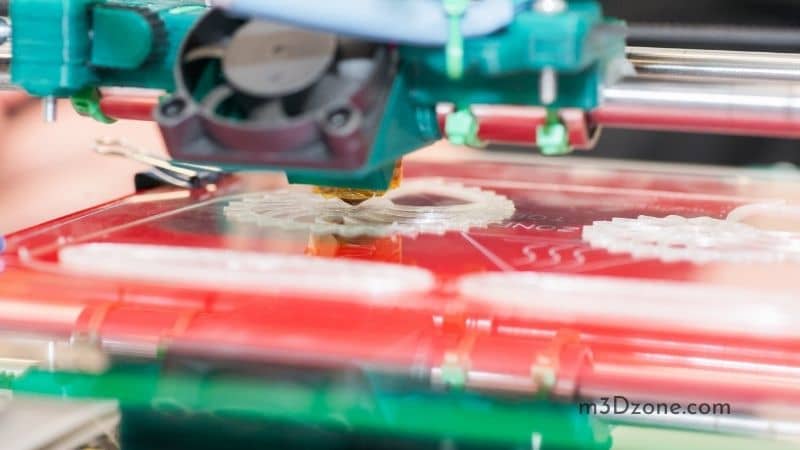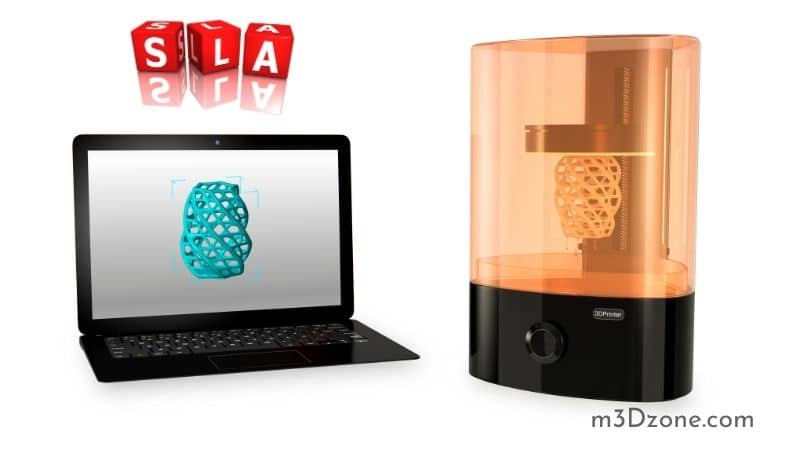Are you wondering what FDM means? And what about FFF technology? Are these terms used in 3D printing technologies intimidating for you?

Fused Deposition Modeling(FDM) and Fused Filament fabrications (FFF) are the same. The FDM or FFF uses additive manufacturing 3D printing technology. The technology relies on material extrusion. Consequently, as the material is selectively deposited layer by layer in a pre-determined path, the end-product is the desired 3D printed part or object.
Quick Navigation
Yes, Fused deposition modeling and Fused Filament Fabrication is the same technology that relies on fabrications of polymers parts using a thermal process. The process induces residual stress, stress concentrations, distortions, and delaminations between layers.
FDM is the most highly used 3D printing technology in the world. Most 3D printing hobbyists use it.
What Does FDM Stand for in 3D Printing? What Is FDM Used For?
FDM stands for Fused Deposition Modeling. FDM technology is a popular type of 3D printing that builds durable and strong accurate parts. Stratasys Inc., a leader in the manufacturing of FDM 3D printers, owns the trademark of this high-performance technology.
In essence, Fused Deposition Modeling is an additive manufacturing technology that enables the construction of three-dimensional objects through a computer-aided manufacturing process.
FDM 3D printing is made possible by production-grade thermoplastics that build tough, accurate, stable, and durable printed parts and items.
(FDM) is applicable in 3D printing technology to solve various aspects of needs that define concept models. FDM remains ideal for the following significant functions:
1. Producing Early Concept Prototypes
FDM 3D technology produces early concept prototypes that are efficient. Notably, built from ABS-M30 production-grade thermoplastic includes the formation of easily hand removed structures on completion.
FDM parts provide the strength and durability properties of a final product. Therefore, FDM parts prove ideal for physical testing.
FDM prototyping is popular with engineers and product designers, more so in the automotive industry. Because it offers benefits that include ASA prototype production though it is slower than SLA and SLS, it’s ideal for functional testing.
Its model closely resembles the final product when looking at properties such as strength, UV stability, heat, and water resistance.
2. Validate Designs
The FDM 3D printer technology validates the designs proposed by designers and engineers. FDM ABS specimens get tested for different conditions. Then, a two-stage model simulation gets underway in the FDM manufacturing process.
Finally, the analysis conducted determines if the prototype truly reflects the desired design.
3. Jigs and Fixture Assembly
Jigs and fixture position, hold, protect and organize components at all stages of a manufacturing process. Metal, plastic, or wood are used in the production of Jigs and Fixtures.
Fused deposition modeling or fused filament fabrication(FFF) simplifies the traditional fabrication process. Consequently, tool-making becomes less expensive and time-consuming. Thus, manufacturers realize a significant improvement in productivity, quality, and efficiency.
How Does FDM Work?
Scott Crump, the founder of the FDM 3D printing revolution, invented a truly remarkable technology.
So, how does FDM work?
- The first step is to load a spool of Thermoplastic filaments in the FDM printers.
- Once the nozzle is hot enough, the filament extrudes from the nozzle tip where it melts.
- The extrusion head moves in selected directions. It allows melted material from the FDM printers to extrude thin strands deposited layer by layer and build volume in pre-determined locations.
- It eventually cools down and solidifies to create the desired object of the 3D printing process.
Cooling fans are attached to the nozzle to aid or hasten the cooling process.
Benefits & Limitations of FDM Technology
A wide range of desktop 3D printers uses FDM technology to acquire a 3D print. Stratasys Inc. has successfully promoted the FDM printer and technology, becoming the world’s leading promoter of FDM and 3D printing technology because of its benefits.
-
Accuracy
FDM printers use a thermoplastic material heated to the melting point then extracted to create the final object or product. Carnegie Mellon University’s computer department’s research asserts that FDM manufacturing processes are accurate within 0.005 inches.
-
Speed
FDM Printers are known for their high performance, and speed is vital. In optimal manufacturing processes, FDM printed parts can be ready in minutes or a few hours. Computer-Aided Printing (CAD) printing ensures you follow only a single step to realize finished products and objects,
-
Ease of Use
FDM printers are simple to use because the printers can create items designed in a CAD program. The entire production process is set up on a computer, making it one of the types of 3D printing that is simple to use.
You need to apply the computer application to start and finish the process as the computer does everything.
-
Affordability
The ceramic and thermoplastic materials used in FDM printers are affordable compared to alternatives. The FDM printers are of modest size, ensuring a part printed doesn’t need manufacturing in extensive facilities. So, it helps lower the expense of producing smaller pieces.
-
Scaling
FDM 3D printing scales parts down to size automatically and still maintains accuracy in the process. FDM technology users can therefore create miniature prototypes for Use in a presentation or as a scaled-down example during sales
Which Is More Robust, FDM or SLA?
SLA has a more potent bonding force of the layers compared to FDM.

FDM Technology
FDM printers use PLA, PETG, or ABS filament materials. Most FDM printers can handle nylon, PVA, TPU, and various PLA blends with a mixture of wood, carbon fiber, ceramic, and metal.
It is an additive manufacturing process that encourages rapid prototyping of designs using CAD software technology.
SLA Technology
SLA stands for Stereolithography Apparatus. Also, it is an additive process, just like the FDM, meaning it builds models or objects layer by layer. However, it uses a curable photopolymer, usually a liquid resin that hardens by applying Ultraviolet light in a curing process.
Difference between FDM and SLA
-
Precision and Smoothness
In FDM printers, the resolution depends on the nozzle size and precision of extruder movements. In FDM printing, the upper layers’ weight may squeeze layers below, warping, shrinking, and damage could occur.
On the contrary, SLA printers consistently produce higher-resolution objects. They are far more accurate than the FDM because a projector or laser with a small optical size determines the resolution.
-
Removal After 3D Printing
FDM printer causes adhesion to the print bed. Thus, it is easy to remove printed objects, and in case the item sticks to the print bed, you can remove it using a palette knife.
By contrast, in SLA 3D printing, it can be challenging to remove a printed model from the print platform. There will be so much resin that you will need a palette knife to remove the 3D model.
-
Postprocessing
In FDM printing, you need to remove supports, especially if the model has overhangs and excess plastic materials. So, you use your fingers or a cutting tool.
A sticky resin covers the SLA printed models that need removal in a bath of isopropyl alcohol. Rubber gloves come in handy to protect yourself from resin and alcohol.
Common FDM Materials
-
PLA Filament
PLA is a popular filament material used in 3D printing. It is a biodegradable and bioactive thermoplastic polyester made from natural plants like corn starch. Its composition makes it an environmentally friendly material.
PLA’s usage includes making parts, prototypes, and products that do not need extreme stress.
-
ABS Filaments
ABS is an amorphous polymer used in 3D print. Production of ABS comes through an emulsion process from three components, or it recycles from itself. It is trendy in the market, and its application is wide. It’s used in production Keyboards, Keycaps, and many others, especially when parts require extra strength.
-
PET
PET belongs to the polyester family. It is a thermoplastic polymer resin combined with two monomers and is widely used to produce many clothes and bottles.
-
PETG
It is an explicit amorphous thermoplastic material that is an enhancement of PET. It improves PET by making it more robust by adding Glycol to the material component of Pet.
-
PTU
PTU is a rubber-like material used in 3D printing to produce semi-flexible parts. Its structure comprises a chain of hard and soft segments that uses a wide range of 3D printing.
Conclusion
FDM printing technology has widely been discussed in this article. So, you now know better how to optimize FDM 3D printing technology to get better results or products.
The FDM printing is here to stay, and the well-researched article enriches your knowledge and enables you to appreciate FDM printing in general.
Recommended Reading
Can You 3D Print Without a Heated Bed?
Yes, you can 3D print without a heated bed! Some 3D printers don't have a heated bed. However, if you don't have a heated bed, you may not have benefits...
What Is a Good 3D Printing Speed?
For slow 3D printers, use 40mm per second to 80mm per second 3D printing speeds. Mid-speed printers work best with 100 mm/s. Fast-speed 3D printers use 150mm/s.
Is PLA Biodegradable? Can You Compost PLA?
PLA remains a bioplastic derived from renewable material, and as such, it should be biodegradable. So, is PLA biodegradable? Let's find out!
